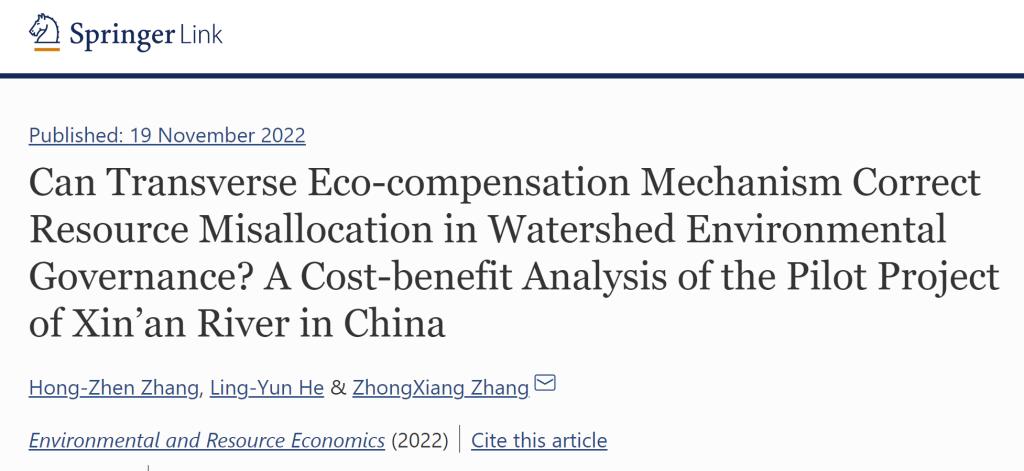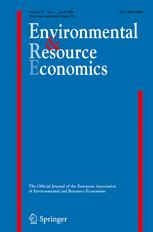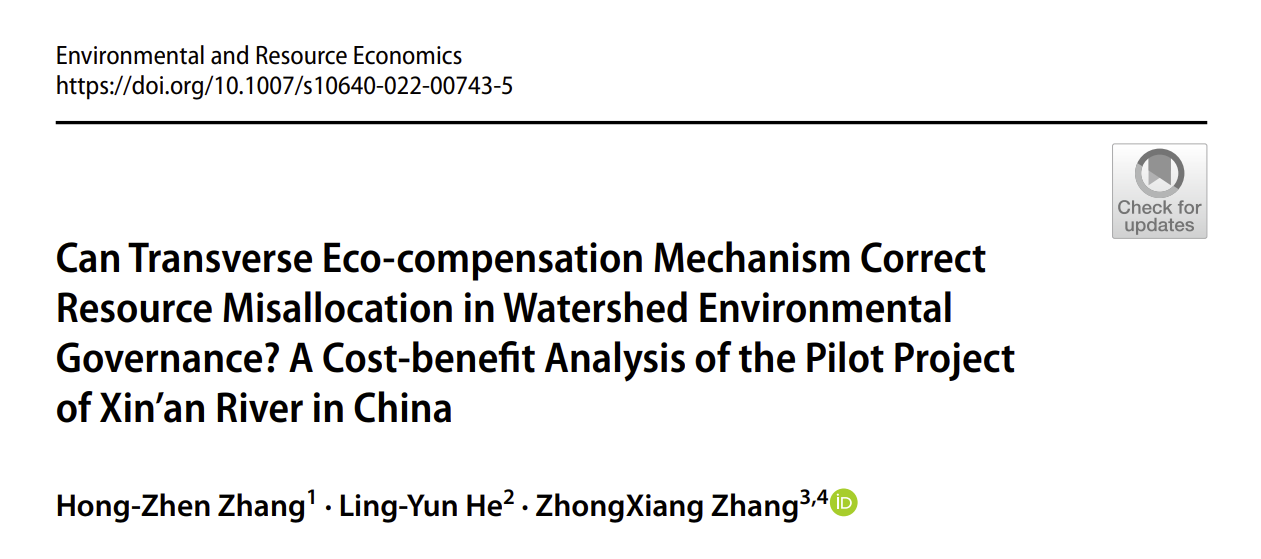时间:2022-11-21
河北大学管理学院讲师张洪振博士、暨南大学经济学院何凌云教授与天津大学马寅初经济学院创院院长、卓越教授,国家能源、环境和产业经济研究院院长张中祥合作的文章“Can Transverse Eco-compensation Mechanism Correct Resource Misallocation in Watershed Environmental Governance? ACost-benefit Analysis of the Pilot Project of Xin’an River in China”在Springer出版社出版的期刊Environmental and Resource Economics在线发表。

该文曾于2020年11月在天津大学马寅初经济学院组织的第二届天津大学博士生学术论坛经济学分论坛和2021年6月在德国柏林举行第26届欧洲环境与资源经济学家学会年会上做过报告。该文发表的期刊Environmental and Resource Economics是欧洲环境与资源经济学家学会会刊,是水平高、评审严格、学界口碑好、位居SSCI经济学科所有期刊前15%的期刊。
内化负外部性与纠正资源错配是解决跨界流域污染的关键。为了纠正生态服务的外部性,经济学家提出了两个经典方案:庇古税和科斯的产权交易方案。然而,囿于水资源产权界定困难、交易成本高、信息不完全,庇古税和科斯方案对于解决规模较大的流域环境污染经常难以适用。尤其是对中国而言,流域上下游的收入差距往往很大,明确上游流域水资源使用者的初始产权(排污权)将导致流域水环境恶化;明确下游流域水资源使用者的初始产权(环境权),将拉大上下游地区收入差距,加剧环境资源错配。为解决跨界流域污染,纠正环境资源错配,中国基于科斯产权理论,创新性地实施了横向生态补偿机制(TECM)。那么,TECM 能否为上游地区纠正过度污染的行动提供经济激励,从而纠正资源错配?本文以中国新安江流域横向生态补偿项目为研究案例。
研究TECM对流域环境治理中资源错配的影响具有重要的政策意义:首先,如果TECM不能有效地弥补上游地区环境治理的正外部性,纠正资源错配,那么TECM就是不可持续的,会导致生态服务长期供给不足;其次,尽管TECM是具有环境效率的,但如果存在严重的资源错配和外部性,TECM就难以有效地推行和应用;最后,流域上游作为环境治理的主体,资源错配和外部性不得到纠正,会加剧上游地区的贫困问题,扩大流域之间的收入差距,可能会导致更为严重的社会问题。
为回答上述问题,本文以新安江横向生态补偿项目为研究案例。新安江项目是中国相对成功和成熟的TECM试点项目,并且,上下游经济发展的不平衡与中国的整体经济结构相似。为分析TECM项目如何为上游地区纠正资源错配(新安江过度污染)的行动提供经济激励,本文应用成本效益分析(CBA) 方法来展示纠正过度污染的行动及其成本,以及 TECM 项目为上游地区提供的经济激励,最后评估TECM 在采取行动纠正资源错配方面的有效性。基于CBA分析,我们发现TECM长期是有效的,可以为上游地区提供经济激励,以纠正造成生产力和福利损失的环境资源分配不当(过度污染)。TECM项目在3%的折现率下长期的净收益现值为9638.6万元。并且在不同折现率的情况下,该结论仍然有效。我们的研究结果对于处理中国和其他地区(如印度、欧洲等上游地区人口和企业多的地区)的跨界流域污染具有一定参考意义。
本文对文献的边际贡献主要体现在以下两个方面。首先,本文丰富了TECM(或PWES)的相关文献。现有对TECM的研究主要集中在其环境效应和运行机制上,而忽略了TECM对资源错配的影响。其次,本文将CBA方法引入流域环境治理资源配置研究。 CBA 方法可以更清楚地显示 TECM 如何为上游地区纠正资源错配(新安江的过度污染)的行动提供经济激励。

Can Transverse Eco-compensation Mechanism Correct Resource Misallocation in Watershed Environmental Governance?
A Cost-benefit Analysis of the Pilot Project of Xin’an River in China
Environmental and Resource Economics
Hong-Zhen Zhang, Ling-Yun He, ZhongXiang Zhang
Abstract
Correcting resource misallocation that creates productivity and welfare losses is the key to correcting transboundary basin pollution. China has proposed a transverse eco-compensation mechanism (TECM) based on the traditional Coase scheme to solve the pollution of transboundary watersheds. But whether it can correct the misallocation of resources that cause productivity and welfare losses has been ignored in existing literature. This paper first conducts a theoretical analysis of the TECM’s resource allocation effect and operation mechanism. And on this basis, we use the cost–benefit analysis (CBA) method to show how TECM produced actions in relevant upstream regions towards correcting excessive pollution, and how TECM provided economic incentives for these regions to undertake these actions. The CBA analysis results are consistent with the theoretical analysis. The TECM project will benefit the upstream region with a discount rate of 3%, and the present value of the net income is 96.4 million yuan. The conclusion still holds in the case of different discount rates. The above results show that the TECM can correct the resource misallocation that creates productivity and welfare losses in cross-basin environmental governance, and provide economic incentives for upstream areas to correct environmental resource misallocation (excessive pollution). Finally, the TECM model has important policy implications for solving the problem of cross-basin pollution in other similar countries.
JEL classification
Q53; Q56; Q58; O13
Keywords
Transverse eco-compensation mechanism; Xin'an River; Resource misallocation; Cost-benefit analysis
文章全文参见链接:
https://link.springer.com/article/10.1007/s10640-022-00743-5
